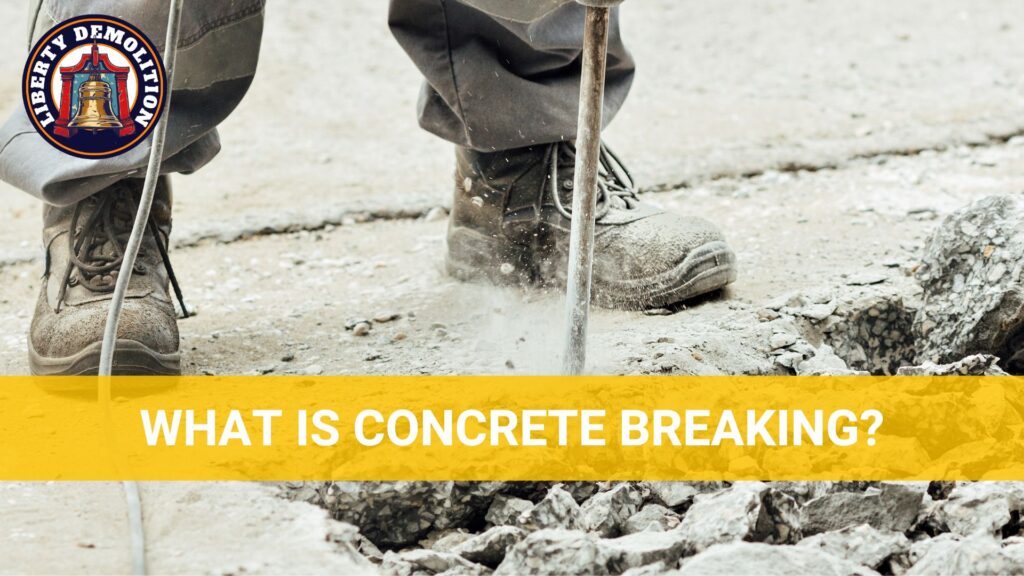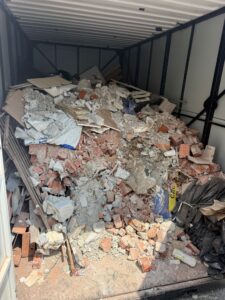Concrete breaking tools are specialized equipment used for breaking or demolishing hardened concrete structures. They range from hand tools to heavy machinery designed specifically for concrete demolition tasks.
Discover more about these essential tools and their applications below.
What is a Concrete Breaking Tool Called?
A concrete breaking tool is an equipment designed to break, demolish, or crush concrete. Concrete breaking tools are essential in construction, renovation, and demolition projects. They are categorized based on their size, function, and power source.
Before we proceed with the types of concrete breakers, let’s first understand why concrete needs to be broken.

What is Concrete Breaking?
Concrete breaking is the process of fragmentation or demolishing concrete structures, surfaces, or elements. Due to concrete’s robust and durable nature, specialized techniques and tools are often required to efficiently break it down.
Why Concrete Needs to Be Broken
- Aging and Deterioration: Over time, concrete can deteriorate due to exposure to environmental elements like water, temperature fluctuations, and chemicals. Broken or crumbling concrete can be a safety hazard, so it’s often necessary to remove and replace it.
- Design Changes: In construction and renovation projects, the design of a space might change, requiring the removal of existing concrete structures or surfaces to make way for new ones.
- Infrastructure Upgrades: Updating underground utilities, such as water lines, sewer systems, or cables, often requires breaking through concrete surfaces.
- Mistakes or Imperfections: During the construction process, if the concrete is not set properly or has visible defects, it might need to be broken and redone.
Common Scenarios that Require Concrete Breaking
- Renovations: Whether it’s a home renovation or remodeling a commercial space, existing concrete walls, floors, or other elements might need to be altered or removed to fit the new design.
- Repairs: Concrete surfaces, like driveways or sidewalks, can develop cracks, chips, or holes over time. In such cases, the damaged parts need to be broken away before repairs can be made.
- Complete Demolitions: When an old building or structure is being taken down to make way for a new one, concrete breaking is an essential step. This involves breaking down all concrete elements of the structure, including walls, floors, pillars, and more.

What is the Best Tool to Break Up Concrete?
The best tool for breaking up concrete often depends on the specific requirements of the job. The size, thickness, and location of the concrete, as well as the intended purpose for breaking it, all play a role in determining the ideal tool. In some cases, a combination of tools may be used to achieve the desired result.
Handheld Tools for Concrete Breaking
Handheld tools are perfect for smaller jobs or areas where precision is required. They’re typically manual, offering control but requiring more physical effort compared to powered machinery.
Sledgehammers
A sledgehammer is a large, heavy hammer used for breaking concrete, especially in areas where precision is not a primary concern. They can range from 10 to 20 pounds. Heavier hammers deliver more force but can be more challenging to swing repeatedly. Longer handles offer more leverage, which makes it easier to deliver a powerful blow. However, they can also be more unwieldy.
Chisels
Chisels are used for more precise work or to start a crack that can then be widened using other tools. Flat chisels are used to create cracks, while bull point chisels can break concrete more extensively. There are also chisels designed specifically for concrete, known as masonry chisels. To use, hold the chisel at a 60-degree angle to the concrete and strike it with a heavy hammer. Repeated strikes in the same spot will cause the concrete to crack.
Pry Bars
Pry bars, also known as crowbars or wrecking bars, are not primarily designed for breaking concrete, but they can help in the process. Once a crack or hole has been created in the concrete, a pry bar can be inserted and used as a lever to break off larger chunks of concrete. They’re also useful for removing nails, prying up old tiles, or separating two bonded objects. Most pry bars are made of heavy-duty steel, which makes them strong enough to handle the force required to break concrete.
Power Tools for Concrete Breaking
For larger projects or when dealing with thick, reinforced concrete, manual handheld tools might not be efficient or effective. In such scenarios, power tools come to the rescue. These devices use electricity, battery, or other power sources to deliver substantial force, making the concrete breaking process quicker and less labor-intensive.
Jackhammers
Jackhammers, often synonymous with pneumatic hammers, are one of the most recognized tools for breaking concrete. They operate by driving an internal hammer up and down, repeatedly pounding the concrete at a high frequency. There are electric jackhammers and pneumatic jackhammers. The latter uses compressed air, which means they require an air compressor to function. Jackhammers are ideal for breaking up large areas of concrete such as roads, pavements, and foundations.
Rotary Hammers
Rotary hammers are versatile tools that can both drill and hammer. They combine rotation with a pounding action, which helps in drilling or chiseling hard materials. Most rotary hammers come with settings that allow the user to either drill, hammer or do both simultaneously. They are ideal for drilling holes in concrete or light chiseling tasks. They are not as powerful as some other tools, but their versatility makes them invaluable in construction. Many models allow for various attachments, including different types of chisels or bits, enhancing their utility.
Demolition Hammers
Demolition hammers are designed primarily for breaking down structures. They provide a pounding action without rotation, delivering more force per blow compared to rotary hammers. They are best suited for vertical work, like breaking down walls or ceilings. They are lighter than jackhammers, making them more manageable for extended use. Many demolition hammers are designed with user comfort in mind, featuring anti-vibration handles and ergonomic grips.
Electric Breakers
Electric breakers are powerful tools that combine the best of both jackhammers and demolition hammers. They deliver heavy-duty force without the need for a compressor, as seen with pneumatic jackhammers. They are often quieter than pneumatic tools and don’t require external power sources like compressors. Electric breakers are suitable for a wide range of tasks, from breaking up driveways to taking down walls. They offer a good balance of power and portability.
Advanced Machinery for Large-Scale Demolition
When the task at hand is extensive, such as the demolition of a large building, bridge, or roadway, handheld tools, and even power tools might be insufficient. In these situations, heavy machinery is employed to ensure that the concrete structures are broken down efficiently, safely, and within a feasible time frame.
Bulldozers
Bulldozers are iconic when it comes to large-scale demolition and construction tasks. A bulldozer uses a massive metal blade in the front to push substantial amounts of material, including rubble, dirt, and other debris. It can also be equipped with a ripper at the back to break hard surfaces. While primarily used for moving and clearing debris, bulldozers can also be instrumental in demolishing smaller structures or leveling concrete surfaces. They can cover large areas quickly, which makes them ideal for clearing sites post-demolition or preparing grounds for construction.
Concrete Crushers
Concrete crushers are specifically designed to break down concrete. These machines exert immense pressure on the concrete. They are usually hydraulic and can be attached to excavators for ease of use. They are perfect for demolishing concrete walls, pillars, or other structures. They are especially useful in areas where explosions or other high-impact methods are impractical. Concrete crushers can break reinforced concrete easily and are often used for recycling purposes, as they can process demolished concrete into reusable aggregates.
Rubble Breakers
Rubble breakers are specialized equipment designed for breaking concrete into smaller, more manageable pieces. Typically mounted on a vehicle or an excavator, rubble breakers use powerful hydraulic hammers to pound and break concrete. They operate in a manner similar to jackhammers but on a much larger scale. They are ideal for breaking down large slabs of concrete or reducing the size of concrete debris for easier transportation and disposal.
Selection Criteria: Choosing the Right Tool for the Job
An inappropriate tool not only slows down the project but can also pose serious risks. Here’s a comprehensive guide to help you make an informed decision in choosing what tools to use:
1. Assessing the Scope of the Project
- Size & Area: Gauge the size of the area that needs work. Small projects like breaking a pathway might only need a sledgehammer or an electric breaker, while larger areas, such as complete building demolition, require heavy machinery.
- Depth & Thickness: The depth of the concrete also matters. Thin slabs might be easier to break, while thicker structures, especially those with reinforcement, require more powerful tools.
- Location: Consider the accessibility of the location. Tight spaces might not accommodate large machinery, while remote locations might make it challenging to source power for electric tools.
- Purpose: Why are you breaking the concrete? If it’s for renovations, you might need precision tools to avoid damaging adjacent structures. For full demolitions, larger and more aggressive tools might be suitable.
2. Understanding Tool Specifications and Capabilities
- Power Source: Tools might be manual, electric, pneumatic, or hydraulic. Your choice might depend on the availability of power sources or the need for mobility.
- Force & Impact: Understand the force or impact energy a tool can deliver. This is especially crucial when dealing with reinforced concrete.
- Versatility: Some tools, like rotary hammers, come with multiple functions. Assess if a multi-purpose tool is beneficial for your needs.
- Attachments & Accessories: Some machinery can be fitted with various attachments to increase their functionality. This can be a cost-effective way of getting more out of a single machine.
3. Considering User Expertise and Safety
- Training: Only trained professionals should operate heavy machinery or power tools. Ensure that the person tasked with the job has received appropriate training.
- Ergonomics: Tools that are ergonomically designed reduce the risk of strain injuries. If a tool is to be used for extended periods, factors like weight, vibration reduction, and grip comfort become crucial.
- Safety Features: Modern tools come equipped with safety features like auto shut-off, anti-vibration handles, or safety clutches. Prioritize tools that emphasize safety.
- Protective Gear: Always ensure that the operator wears protective gear, including goggles, gloves, ear protection, and safety boots. The gear might vary depending on the tool and the nature of the project.

Can Concrete Break Easily?
The durability and longevity of concrete as a building material are well known. However, it’s not invincible. While it can withstand substantial pressures and adverse environmental conditions, concrete can, under certain circumstances, break or crack. Understanding the factors that affect concrete’s resilience can help in maintaining its structural integrity and can guide decisions related to demolition or repair.
Composition of Concrete
- Quality of Ingredients: The grade of cement, the cleanliness of water, and the quality of aggregates play crucial roles in determining the strength of the resultant concrete.
- Mix Proportions: The ratio of the ingredients can affect strength. For instance, excessive water can weaken the concrete, making it more susceptible to breaking.
- Curing Process: Concrete needs to be kept moist after it’s poured to achieve its maximum strength. An inadequately cured concrete can be weaker and more prone to cracking.
External Factors
- Environmental Conditions: Concrete exposed to aggressive environmental conditions, like repeated freeze-thaw cycles, can develop cracks. Chemical exposure, such as that from de-icing salts, can also degrade concrete over time.
- Physical Impact: A sudden impact, like a heavy object falling on a concrete slab, can cause it to break, especially if the concrete is of inferior quality or if it has pre-existing vulnerabilities.
- Load-Bearing Capacity: Every concrete structure has a load-bearing capacity. Exceeding this load can cause the concrete to break.
- Ground Movement: Earthquakes, sinkholes, or even minor ground shifts can lead to cracks in concrete structures.
Inherent Weaknesses
- Reinforcement Issues: Reinforced concrete, which contains steel bars or mesh, is stronger than non-reinforced concrete. However, if the steel corrodes, it can expand and crack the concrete.
- Construction Joints: Places where new concrete meets old, known as construction joints, can be weak points if not appropriately treated.
- Design Flaws: Poorly designed structures, without considering load distribution or expansion factors, can lead to cracks or breaks in concrete.
Age and Wear
- Natural Degradation: Over time, even the most robust concrete structures can degrade due to environmental exposure and regular wear and tear.
- Previous Repairs: Sometimes, repairs made to concrete structures can introduce weaknesses, especially if they were not done correctly.

What Is the Difference Between Cement and Concrete?
Cement and concrete are terms that are often used interchangeably, but they refer to distinctly different materials.
At their core, cement and concrete differ in composition and purpose. Cement is a fine, powdery material that acts as a binder. When mixed with water, it forms a paste that hardens over time. Cement is a key ingredient in concrete, which binds the aggregates together.
Cement is primarily made from limestone, clay, shells, and silica. These ingredients are heated to high temperatures in a kiln, producing clinker. The clinker is then ground down into the fine powder we recognize as cement. There are different types of cement, including Portland cement, the most commonly used type in concrete mixtures.
Apart from being an essential ingredient in concrete, cement is also used in making mortar, which is used for binding bricks, tiles, and stones in masonry construction
On the other hand, concrete is a mixture of cement, water, and aggregates (like sand, gravel, or crushed stone). When these components are combined, they form a malleable mixture that can be shaped and then hardened into a strong, durable material.
Concrete is composed of cement (typically 10-15% of the total mass), water (about 15-20%), and aggregates (65-75%). The specific ratios can vary based on the desired properties of the concrete. Due to its strength and versatility, concrete is used in a wide range of construction projects, from small residential walkways to massive infrastructure projects like bridges, roads, and skyscrapers.
Break the Stigma, Get the Services of the Pros!
Understanding the composition of concrete and the tools required for its demolition is crucial in the construction and demolition industry. From the basic definitions of concrete breaking tools to the subtle differences between cement and concrete, having this knowledge ensures better decision-making in projects.
If you want your job done right, get the services of professional demolition contractors who are not only experts in using concrete breaking tools but have long years of experience to back up their claims. At Liberty Demolition, we’re not just experts in the field; we are dedicated to safety, environmental responsibility, and ensuring our customers are always satisfied. Whether it’s residential, commercial, industrial, or selective demolition, our demolition contractors in Philadelphia are equipped to provide a seamless, eco-friendly solution, paired with efficient waste management and recycling.
When you’re in need of top-notch demolition services, remember Liberty Demolition’s commitment to excellence in every project. Ready to redefine your demolition experience? Choose Liberty Demolition and contact us today! 🏢🔨






